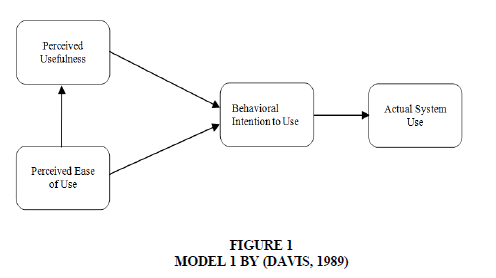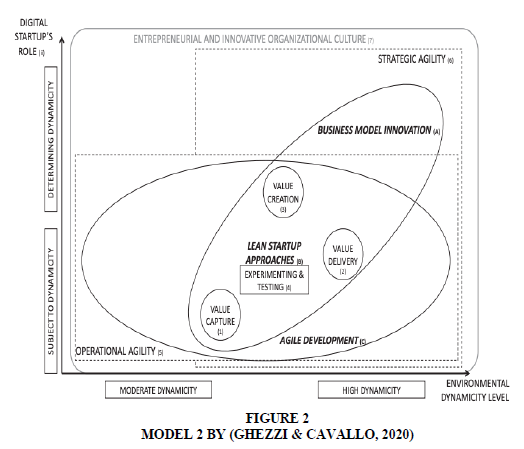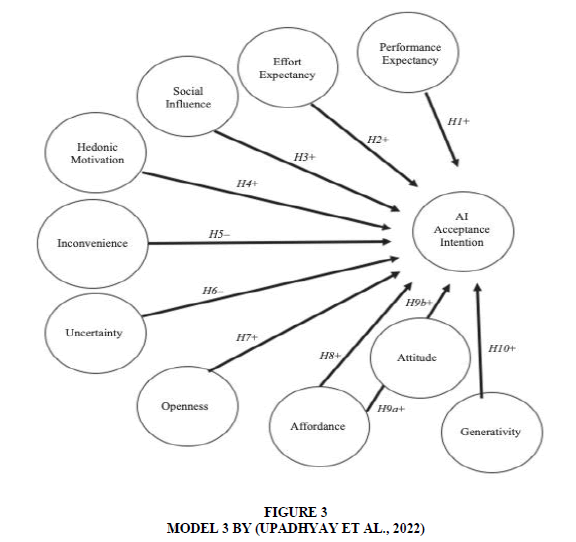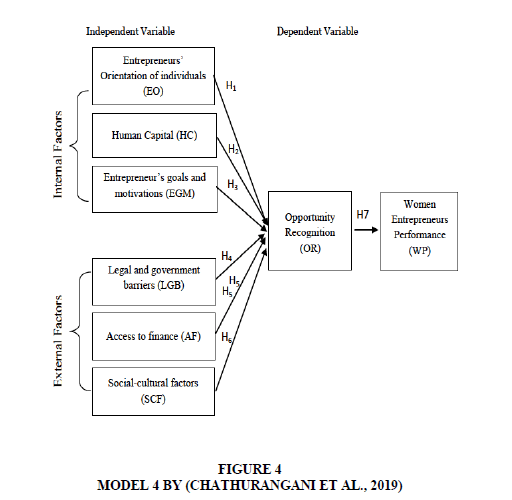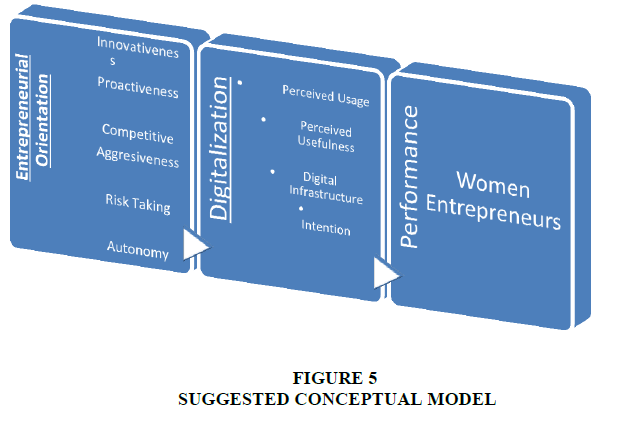Research Article: 2023 Vol: 27 Issue: 3S
Analyzing the Influence of Digitalization in Women Entrepreneurship using Entrepreneurial Orientation
Prerna Katoch, Shri Mata Vaishno Devi University Katra
Syeda Shazia Bukhari, Shri Mata Vaishno Devi university katra
Suhail Gupta, Shri Mata Vaishno Devi university katra
Citation Information: Katoch, P., Bukhari, S.S., & Gupta, S. (2023). Analysing the influence of digitalization in women entrepreneurship using entrepreneurial orientation. Academy of Marketing Studies Journal, 27(S3), 1-10.
Abstract
The concept of digitalization has been undertaken as a part of academia quite rigorously in the past years. One of its reasons being its integration into every possible advent of business. While some of the important components of digitalisation have been successfully completed by the researchers, there are a few domains that require to be looked upon. The main purpose of this study is to highlight the increasing impact of entrepreneurship in an emerging economy like India and understand the potential areas in which there can be betterment of situation provided. The study has included a review of around 50 papers in the area of digitalisation and entrepreneurship. However, based on the detailed analysis of the models involved in the process a total of four models are shortlisted to be mentioned in the study. The study has identified some of the major gaps lying in the literature corresponding to digitalisation and entrepreneurship. A model including the components of entrepreneurial orientation, digitalisation and performance has been created to understand the situation of women entrepreneurship in an emerging economy like India.
Keywords
Entrepreneurship; Entrepreneurs; Model; Digitalization
Introduction
The literature surrounding the concept of digitalisation in entrepreneurship has taken great leap in the academics (Antoncic et al., 2018; Llanos-Contreras et al., 2020). The increasing role of technology and digital aspects have considered the researchers to make digitalisation a part of such studies. The concept of entrepreneurship is a growing area in the present times where the number of entrepreneurs have seen a rise in the recent times as well. The literature pertaining to entrepreneurship and its impact across several geographical and sociological domains have been abundant. However, with the role of technology and digitalisation being introduced into the space, the literature have been redefined with models and concepts including such elements. Both entrepreneurship and technology acceptance is a highly researched area in the present times and there are many researchers who have combined both these aspects to put forward a number of unique findings (Ciampi et al., 2021; Penco et al., 2022). The study here attempts to review some of the models which can incorporate the essence of entrepreneurship and digitalisation in order to understand the areas of gap residing in the present body of knowledge. The main purpose of this study is to highlight the increasing impact of entrepreneurship in an emerging economy like India and understand the potential areas in which there can be betterment of situation provided. India being an emerging economy is a growing hub for entrepreneurs who have novel propositions to disrupt the market. In such a time of growth, the analysis of the academic literature can be cultivated quite effectively to be able to establish impactful and strong models to help in practical and social implementations (Torres & Augusto, 2020). The study here would there for be engaged in understanding the following research questions-
RQ1: What are the most effective models in the current body of literature with respect to entrepreneurship and digitalisation?
RQ2: Can these models be used to shape the situation of implementing digitalisation in the entrepreneurship module?
In order to understand the above research questions and arrive at a conclusive summary, the study adopts an in depth analysis of the past models.
Background
Online transactions, which includes e-commerce business, internet advertising, online payment processing and data storage, is what the word technology (Chaithralaxmi & N. Shruthi, 2016) refers to. The word digitization, which refers to the fundamental process of transferring data from analogues to digital, has been the subject of a huge and expanding body of research. While various definitions of the concept "digitalization" have been proposed, this research chooses to utilize the definition provided by ((Moore et al., 2015)) in Gartner, which describes it as "the use of information in the entrepreneurship activities." According to several academics (Asadullah et al., 2018; Bloomberg, 2018; Nambisan, 2017), leaders and entrepreneurs are increasingly using the terms digital and digitalization to relate to the usage of technology. According to a prior research (Birley et al., 1987), women must be trained in order for the country's economic growth and sustainability. Women entrepreneurs are encouraged to start, expand and thrive in the competitive market as a result of digitalization. “Online commerce is a relatively new business strategy that has caught on in practically every industry. Because of the rapid growth of information and communications technology, this critical domain has evolved into a method for effectively directing commercial operations beyond organizational borders. Online commerce, in particular, may break down barriers to entry and enable firms to enter previously inaccessible industries without the need for a powerful proximity. In this study, online business is defined as any sort of internet-based retail sale that includes all parts of running a company that sells goods, products and services, such as advertising, customer acquisition and retention, sourcing, building business associates and consumer awareness and education.”
Entrepreneurial mindset and results Entrepreneurial orientation intention (EO) is a key factor in a company's success. (Miller, 1983) defined entrepreneurial orientation as comprising of three dimensions: innovativeness, proactiveness, and risk-taking. Proactiveness is the pursuit of benefits and potential rivalry in expectation of possible demand to make change happen and shape this same business climate, while process innovation is the firm's ability and commitment to assist creativity, fresh concepts and experimentation that may result in new product lines and services (Lumpkin & Dess, 1996). When it comes to risk-taking, it refers to a company consciously dedicating resources to initiatives that have a high probability of success but also a strong likelihood of failures (Lumpkin & Dess, 1996; Miller & Friesen, 1978). Risk-taking, on the other hand, is frequently connected with entrepreneurs activities, and most successful entrepreneurs are risk-takers (Kuratko et al., 2001). According to (Miller, 1983), these three elements of EO form a basic unidimensional orientation strategic approach. A large number of studies have discovered positive links among entrepreneurial orientation and performance (Covin & Slevin, 1991; Kraus et al., 2012; Kreiser et al., 2002; Lumpkin & Dess, 1996; Wiklund, 1999). EO has also been linked to improved export performance (Ibeh, 2003), as well as company size, economic expansion and growth (Tang et al., 2007). In China, studies have revealed that EO has a beneficial impact on small business growth (Gürbüz & Aykol, 2009) and non-state earnings quality.”
Women entrepreneur is defined by (Noor et al., 2021) as “a woman who utilizes her skills, means, and knowledge to establish a new business venture by facing the issues and challenges until attaining financial gain by a business venture” and refer to women’s entrepreneurship as decision-making power, control over resources, and easy access to information. (Kothawale, 2013) defines women enterprise as “a unit of organization relating to service or business enterprise managed by one or more women entrepreneurs having individually or jointly a share capital of not less than 51% as shareholders of the private company, limited company or members of Co-Operative society”. “Profound structural changes in the world provide vast opportunities for both males and females, but significantly change the status of women in the marketplace, consequently, entrepreneurship becomes a vibrant and growing trend among women internationally (Liñán et al., 2022). The primary motivation of low-income women to become an entrepreneur is to generate income, where for some other women entrepreneurs, self-fulfilment or fostering a worthwhile cause is also important as profits (Coughlin & Thomas, 2002). Developing strategies is need of the hour for women to strengthen their decision-making process and leadership in their businesses and also it can offer some benefits to their families and overall economic development (Laudano et al., 2019). The creation of enterprise by a woman offers flexibility to the woman, such as she can balance her work and family responsibilities, support family income, and help other women by offering employment. Moreover, women's entrepreneurship enhances a woman’s self-image, builds a greater degree of self-reliance (Coughlin & Thomas, 2002). Hence, (Panda, 2018) claims that entrepreneurship offers women a platform for self-expression and fulfillment, provides economic security, empowers them as individuals.”
The literature above have helped in identifying the prospects of entrepreneurial orientation, the role of entrepreneurship development in women and the digitalisation factor being present all across. However, the main aim is to find out the models encompassing these issues and generate a novel one for the future. The next sections would explain the same in a systematic manner.
Research Methodology
The study here is an attempt to arrive at the potential research gaps in the current body of knowledge in terms of the existing models integrating entrepreneurship and digitalisation. Through this particular research, the aim is to identify the models being used over a period of time when integrating the two concepts and find out of there exists a scope for generating a new model. In order to do so, the study here adopts a qualitative method which includes a set of secondary sources of data to arrive at the existing models. The process of collecting secondary sources of data includes a step wise scrutiny method for including the final set of models. The study has included a review of around 50 papers in the area of digitalisation and entrepreneurship. However, based on the detailed analysis of the models involved in the process a total of four models are shortlisted to be mentioned in the study. These three models have been selected based on the number of times their usage are made in terms of the individual factors included in the study. Moreover, the models are discussed based on the relevance of it in terms of the Indian entrepreneurship scenario as the study is focused in India. The next stage in the study involves listing out the models analysed and highlighting the gaps that can be noticed.
Results and Findings
The main purpose of the study is to provide a detailed understanding on the existing models in the literature with respect to digitalization and entrepreneurship. The study attempts to put forward a model especially catering towards the entrepreneurs in a country like India Figures 1-5.
Figure 1: Model 1 By (Davis, 1989).
Figure 2: Model 2 By (Ghezzi & Cavallo, 2020).
Figure 3: Model 3 by (upadhyay et al., 2022).
Figure 4: Model 3 by (upadhyay et al., 2022).
Firstly, the digital entrepreneurship studies in the past have largely been done by using the technology acceptance model which is popularly known as TAM. The same have been extended by several researchers to understand the aspect of entrepreneurship. The TAM model consists of basically two major attributes which is perceived ease of use and perceived usefulness to determine the usage and behavioural intention among the required set of respondents.
The model was put forward by (Davis, 1989) in order to understand the adoption of technology among the consumers. The model has been largely used in the past to understand the aspects of digital evolution. The two constructs in the model can have a good impact on finally adopting a particular digitalized object. The model has been extended by many researchers in the field of digital entrepreneurship as well such as (Jaziri & Miralam, 2019; Lin & Lin, 2021). In this particular study as well, the three factors of TAM have been included to measure the performance of the women entrepreneurs.
The second model being identified in literature is the one developed by (Ghezzi & Cavallo, 2020). The model focuses on providing an integrated framework to help connect with the business model innovations being brought forward by the digital start-ups. It also takes into consideration the aspects of lean approaches and agile development. The model generated is shown below.
The model developed here is an advanced version of digital entrepreneurship and focuses on start-ups who are mostly dependent on the digital space for their revenue. The study here however, is attempting to showcase a simpler model as it involves the women entrepreneurs and that too in a region like Jammu & Kashmir.
The next model to be enquired as a part of the first objective in the study has been developed to measure the intention to adopt artificial intelligence in entrepreneurship. The model developed by (Upadhyay et al., 2022) have included constructs from the UTAUT model developed by (Venkatesh et al., 2003) along with the other elements being provided by various researchers in the past.
The model reflects the parameters being hypothesized to understand the acceptance intention of AI among the entrepreneurs. The model showed successful results. However, the model suggests looking into more advanced forms of involving technology into practice, the study here would require to indulge in a simpler model.
There has been a model put forward by (Chathurangani et al., 2019) about women entrepreneurs specifically and included a number of internal and external factors can potentially impact on the performance of the firm. The model being constructed incorporates the role of technology and digital dominance through these factors but does not involve a direct interference. The model however focuses on women entrepreneurship and highlights some important aspects in relation to it specifically. The motivation, socio-cultural aspects, entrepreneurs’ orientation, human capital, access to finance and even the legal environment surrounding it.
These models being analyzed in the study have tried to capture the essence of entrepreneurship in relevance to the digital methods and have established themselves.
Conclusion & Future OutLook
From the study above it has been established that over a period of time the number of models developed in terms of integrating digitalisation into entrepreneurship is quite diverse in nature. However these models include a number of important factors in them which can be found to have commonality in majority of the models being studied in the literature. One such aspects is the technology acceptance model or TAM which is found to be one of the most common model to be used for understanding the adoption of technology among various stakeholders. The variables in the model namely perceived usefulness and perceived ease of use along with the intent of adopting the technology are found to be the common elements in majority of the models in the regard. The models go from understanding the business model transitions to that of including the attitudinal changes impacting the adoption of certain technologies in entrepreneurship. However looking at the above models it is found that the two types of factors which can cause the scenario to have further insights could be including entrepreneurial orientation factors to understand the performance of entrepreneurs. When talking about digitalisation, the most important factors that have been illustrated in the paper as well include the importance of digital infrastructure and the components included in the TAM model. It can also be stated that a mediating effect of digitalisation between entrepreneurial orientation as found in the last model on that of the performance of the entrepreneurs can help in generating interesting insight in case of entrepreneurs belonging to India. The components of the entrepreneurial orientation model is quite basic in nature and are relevant for studies which are looking to formulate a new conceptual model. These elements cannot be ignored by any entrepreneur and must be taken care of at every step of the business. While these factors have significant impact on the performance of the entrepreneurs on different situation, it is important that the mediating effect of digitalisation is also measured. The inclusion of the digitalisation factor can cause the new model suggestion to have further insights into the present body of knowledge and help the entrepreneurs especially in a country like India to grow.
India is a land of diverse ethnicity and includes one of the highest population in the world. With increase in the number of entrepreneurship venture, there is also an increase in the number of women entrepreneurs in the country as well. In the review conducted it has been found that the number of research focusing on women entrepreneurs especially in a country like India is quite scarce. Along with suggesting a conceptual model for future it can be suggested that the model will be optimum to understand the performance of women entrepreneurs in a situation where there is the constant impact of digitalising on businesses. Hence, to summarise the study here it can be concluded that a model including the basic elements of entrepreneurial orientation and the mediating effect of digitalisation can help in identifying the performance of women entrepreneurs and how it can be impacted in the future. The following gaps have been identified for which the extracted conceptual model can be suggested.
Research Gap 1: From the literature review, it is found that this type of research entrepreneurial orientation and firm performance of women entrepreneurs with mediating effect of digitalization has not been significantly done in India.
Research Gap 2 : There are many states in India in which gender specific study needs to be conducted specifically for entrepreneurship such as no study has been done on women entrepreneurs relating with digitalization has not been in North India.
Research Gap 3: Women are considered as an important asset of the society and they have to manage their work along with managing their family and sometimes it creates stress for them to manage all the things and they have to leave their jobs but entrepreneurship provides them freedom and when their business is digitalized they will enjoy more benefits and can utilise their full potential (digitalization performance increase and work life balance).
The suggested model to address the above research gaps is shown below.
The above model generated is the result of the study including three main components and it must be analysed in the future to obtain better academic insight into the situation of women entrepreneurship and digitalisation.
References
Antoncic, J. A., Antoncic, B., Gantar, M., Hisrich, R. D., Marks, L. J., Bachkirov, A. A., Li, Z., Polzin, P., Borges, J. L., Coelho, A., & Kakkonen, M.-L. (2018). Risk-Taking Propensity and Entrepreneurship: The Role of Power Distance. Journal of Enterprising Culture, 26(01), 1–26.
Indexed at, Google Scholar, Cross Ref
Asadullah, A., Faik, I., & Kankanhalli, A. (2018). Digital Platforms: A Review and Future Directions. Twenty-Second Pacific Asia Conference on Information Systems.
Birley, S., Moss, C., & Saunders, P. (1987). Do Women Entrepreneurs Require Different Training? American Journal of Small Business, 12(1), 27–36.
Bloomberg, J. (2018). Digitization, Digitalization, And Digital Transformation: Confuse Them At Your Peril.
Chaithralaxmi, T., & N. Shruthi. (2016). E-Commerce in India-Opportunities and Challenges. International Journal of Latest Trends in Engineering and Technology, 505–510.
Chathurangani, H. B. P., Hemathilake, D. H. U., & Samudrika, K. P. N. (2019). Factors affecting on the performance of women entrepreneurs’ in small and medium entities.
Ciampi, F., Demi, S., Magrini, A., Marzi, G., & Papa, A. (2021). Exploring the impact of big data analytics capabilities on business model innovation: The mediating role of entrepreneurial orientation. Journal of Business Research, 123, 1–13.
Indexed at, Google Scholar, Cross Ref
Coughlin, J. H., & Thomas, A. R. (2002). The Rise of Women Entrepreneurs: People, Processes, and Global Trends.
Covin, J. G., & Slevin, D. P. (1991). A Conceptual Model of Entrepreneurship as Firm Behavior. Entrepreneurship Theory and Practice, 16(1), 7–26.
Davis, F. D. (1989). Perceived Usefulness, Perceived Ease of Use, and User Acceptance of Information Technology. MIS Quarterly, 319-340.
Ghezzi, A., & Cavallo, A. (2020). Agile Business Model Innovation in Digital Entrepreneurship: Lean Startup Approaches. Journal of Business Research, 110, 519–537.
Indexed at, Google Scholar, Cross Ref
Gürbüz, G., & Aykol, S. (2009). Entrepreneurial management, entrepreneurial orientation and Turkish small firm growth. Management Research News, 32(4), 321–336.
Indexed at, Google Scholar, Cross Ref
Ibeh, K. I. N. (2003). Toward a Contingency Framework of Export Entrepreneurship: Conceptualisations and Empirical Evidence. Small Business Economics, 20(1), 49–68.
Indexed at, Google Scholar, Cross Ref
Jaziri, R., & Miralam, M. (2019). Modelling the crowdfunding technology adoption among novice entrepreneurs: an extended TAM model. Entrepreneurship and Sustainability Issues, 7(1), 353–374.
Indexed at, Google Scholar, Cross Ref
Kothawale, C. P. (2013). Women Entrepreneurship Development: Problems & Prospects . International Multidisciplinary Research Journal, 2(1).
Indexed at, Google Scholar, Cross Ref
Kraus, S., Rigtering, J. P. C., Hughes, M., & Hosman, V. (2012). Entrepreneurial orientation and the business performance of SMEs: a quantitative study from the Netherlands. Review of Managerial Science, 6(2), 161–182.
Kreiser, P. M., Marino, L. D., & Weaver, K. M. (2002). Assessing the Psychometric Properties of the Entrepreneurial Orientation Scale: A Multi-Country Analysis. Entrepreneurship Theory and Practice, 26(4), 71–93.
Indexed at, Google Scholar, Cross Ref
Kuratko, D. F., Goodale, J. C., & Hornsby, J. S. (2001). Quality Practices for a Competitive Advantage in Smaller Firms. Journal of Small Business Management, 39(4), 293–311.
Indexed at, Google Scholar, Cross Ref
Laudano, M. C., Zollo, L., Ciappei, C., & Zampi, V. (2019). Entrepreneurial universities and women entrepreneurship: a cross-cultural study. Management Decision, 57(9), 2541–2554.
Indexed at, Google Scholar, Cross Ref
Lin, W.-P., & Lin, T.-W. (2021). An Empirical Study on e-Commerce User’s Technology Acceptance Behavior and the Entrepreneurship Strategy in China Base on TSC-TAM Model. Proceedings of the 2021 International Conference on Control and Intelligent Robotics, 562–566.
Indexed at, Google Scholar, Cross Ref
Liñán, F., Jaén, I., & Martín, D. (2022). Does entrepreneurship fit her? Women entrepreneurs, gender-role orientation, and entrepreneurial culture. Small Business Economics, 58(2), 1051–1071.
Indexed at, Google Scholar, Cross Ref
Llanos-Contreras, O., Alonso-Dos-Santos, M., & Ribeiro-Soriano, D. (2020). Entrepreneurship and risk-taking in a post-disaster scenario. International Entrepreneurship and Management Journal, 16(1), 221–237.
Indexed at, Google Scholar, Cross Ref
Lumpkin, G. T., & Dess, G. G. (1996). Clarifying the entrepreneurial orientation construct and linking it to performance. Acad. Manag. Rev, 21, 135–172.
Indexed at, Google Scholar, Cross Ref
Miller, D. (1983). The Correlates of Entrepreneurship in Three Types of Firms. Management Science, 29(7), 770–791.
Indexed at, Google Scholar, Cross Ref
Miller, D., & Friesen, P. H. (1978). Archetypes of strategy formulation. Manag. Sci, 24, 921–933.
Moore, S. A., Rodger, K., & Taplin, R. (2015). Moving beyond visitor satisfaction to loyalty in nature-based tourism: a review and research agenda. Current Issues in Tourism, 18(7), 667–683.
Indexed at, Google Scholar, Cross Ref
Nambisan, S. (2017). Digital Entrepreneurship: Toward a Digital Technology Perspective of Entrepreneurship. Entrepreneurship Theory and Practice, 41(6), 1029–1055.
Indexed at, Google Scholar, Cross Ref
Noor, S., Isa, F. M., & Nor, L. M. (2021). Women Empowerment Through Women Entrepreneurship: A Comparison Between Women Entrepreneurs and Fulltime Housewife in Pakistan. Iranian Journal of Management Studies, 14(2), 347–363.
Panda, A. C. (2018). Circular RNAs Act as miRNA Sponges (pp. 67–79).
Penco, L., Profumo, G., Serravalle, F., & Viassone, M. (2022). Has COVID-19 pushed digitalisation in SMEs? The role of entrepreneurial orientation. Journal of Small Business and Enterprise Development.
Tang, Y.-Y., Ma, Y., Wang, J., Fan, Y., Feng, S., Lu, Q., Yu, Q., Sui, D., Rothbart, M. K., Fan, M., & Posner, M. I. (2007). Short-term meditation training improves attention and self-regulation. Proceedings of the National Academy of Sciences, 104(43), 17152–17156.
Indexed at, Google Scholar, Cross Ref
Torres, P., & Augusto, M. (2020). Digitalisation, social entrepreneurship and national well-being. Technological Forecasting and Social Change, 161, 120279.
Indexed at, Google Scholar, Cross Ref
Upadhyay, N., Upadhyay, S., & Dwivedi, Y. K. (2022). Theorizing artificial intelligence acceptance and digital entrepreneurship model. International Journal of Entrepreneurial Behavior & Research, 28(5), 1138–1166.
Indexed at, Google Scholar, Cross Ref
Venkatesh, Morris, Davis, & Davis. (2003). User Acceptance of Information Technology: Toward a Unified View. MIS Quarterly, 27(3).
Indexed at, Google Scholar, Cross Ref
Wiklund, J. (1999). The Sustainability of the Entrepreneurial Orientation—Performance Relationship. Entrepreneurship Theory and Practice, 24(1), 37–48.
Indexed at, Google Scholar, Cross Ref
Received: 19-Nov-2022, Manuscript No. AMSJ-22-12913; Editor assigned: 20-Nov-2022, PreQC No. AMSJ-22-12913(PQ); Reviewed: 21-Dec-2022, QC No. AMSJ-22-12913; Revised: 24-Jan-2023, Manuscript No. AMSJ-22-12913(R); Published: 08-Feb-2023
